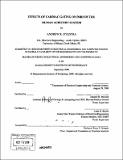| dc.contributor.advisor | Jennifer R. Melcher and Louis D. Braida. | en_US |
| dc.contributor.author | Dykstra, Andrew R. (Andrew Richard) | en_US |
| dc.contributor.other | Massachusetts Institute of Technology. Dept. of Electrical Engineering and Computer Science. | en_US |
| dc.date.accessioned | 2009-06-30T16:25:59Z | |
| dc.date.available | 2009-06-30T16:25:59Z | |
| dc.date.copyright | 2008 | en_US |
| dc.date.issued | 2008 | en_US |
| dc.identifier.uri | http://hdl.handle.net/1721.1/45852 | |
| dc.description | Thesis (S.M.)--Massachusetts Institute of Technology, Dept. of Electrical Engineering and Computer Science, 2008. | en_US |
| dc.description | Includes bibliographical references (leaves 20-22). | en_US |
| dc.description.abstract | Guimaraes et al. (1998) showed that sound-evoked fMRI activation in the auditory midbrain was significantly improved by a method which reduces image signal variability associated with cardiac-related brainstem motion. The method, cardiac gating, synchronizes image acquisition to a constant phase of the cardiac cycle. Since that study, several improvements to auditory fMRI have been made, and it is unclear whether cardiac gating still yields worthwhile benefits. The present study re-evaluated the effects of cardiac gating for detecting fMRI activation with current auditory fMRI standards. In 11 experiments, we directly compared fMRI activation for images acquired with a fixed repetition time (ungated) vs. those acquired by triggering image acquisition (gated) to the oxygen saturation at the fingertip (SpO2), an indirect measure of cardiac activity. Three of these experiments compared the effects of gating with the Sp02 signal vs. gating with the R-wave of the electrocardiogram (ECG). fMRI activation was routinely detected at all levels of the auditory pathway from the cochlear nucleus to the auditory cortex. Compared to ungated acquisitions, cardiac gating with the SpO2 reduced image signal variability in all centers of the auditory system and increased the magnitude of activation in the inferior colliculus (p < 0.01) and medial geniculate body (p < 0.1). | en_US |
| dc.description.abstract | (cont.) Simultaneous measurements of the SpO2 and ECG indicated that the peak of the SpO2 signal followed the ECG R-wave by approximately 400 ms, placing early images in a motion-stable phase of the cardiac cycle during Sp02-gated experiments. This may account for the fact that image signal variability with Sp02-gated acquisitions was always lower than with ECG-gated acquisitions. That sound-evoked activation could be regularly detected without cardiac gating indicates that gating may not be worth the minimal experimental complexity it entails. However, in experiments attempting to measure responses to sounds that evoke small changes in fMRI signal, especially in the auditory midbrain or thalamus, or when one interested in individual variability rather than group averages, gating may prove extremely beneficial. | en_US |
| dc.description.statementofresponsibility | by Andrew R. Dykstra. | en_US |
| dc.format.extent | 32 leaves | en_US |
| dc.language.iso | eng | en_US |
| dc.publisher | Massachusetts Institute of Technology | en_US |
| dc.rights | M.I.T. theses are protected by
copyright. They may be viewed from this source for any purpose, but
reproduction or distribution in any format is prohibited without written
permission. See provided URL for inquiries about permission. | en_US |
| dc.rights.uri | http://dspace.mit.edu/handle/1721.1/7582 | en_US |
| dc.subject | Electrical Engineering and Computer Science. | en_US |
| dc.title | Effects of cardiac gating on fMRI of the human auditory system | en_US |
| dc.type | Thesis | en_US |
| dc.description.degree | S.M. | en_US |
| dc.contributor.department | Massachusetts Institute of Technology. Department of Electrical Engineering and Computer Science | |
| dc.identifier.oclc | 319705852 | en_US |
